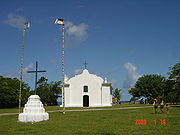
Trancoso, Bahia
Encyclopedia


Porto Seguro
Porto Seguro is a municipality in the Brazilian state of Bahia. It is the site where the Portuguese explorer Pedro Álvares Cabral first set foot on Brazilian soil on April 22, 1500...
in the state of Bahia
Bahia
Bahia is one of the 26 states of Brazil, and is located in the northeastern part of the country on the Atlantic coast. It is the fourth most populous Brazilian state after São Paulo, Minas Gerais and Rio de Janeiro, and the fifth-largest in size...
, Brazil
Brazil
Brazil , officially the Federative Republic of Brazil , is the largest country in South America. It is the world's fifth largest country, both by geographical area and by population with over 192 million people...
. The region was the landing point of the Portuguese explorer, Pedro Alvares Cabral
Pedro Álvares Cabral
Pedro Álvares Cabral was a Portuguese noble, military commander, navigator and explorer regarded as the discoverer of Brazil. Cabral conducted the first substantial exploration of the northeast coast of South America and claimed it for Portugal. While details of Cabral's early life are sketchy, it...
onto Brazil, on April 21, 1500. It was founded by Jesuit Priests on 1583, with the name São João Baptista dos Indios.
Shaped as a rectangle, the village retains the original style of its housing architecture. It is famous for its beaches, such as Praia dos Nativos, Praia dos Coqueiros and Praia do Espelho. In recent years the location has been developed by the hotel industry, including the French Club Mediterranée, which has boosted real estate value.
The federal Ministry of the Environment is currently expanding several National Parks and Natural Reserves nearby with the goal of preserving remaining areas of Atlantic Rain Forest. In addition, Trancoso is located at the starting point of a state Environmental Protection Area, the APA Caraíva-Trancoso, whose goal is to curtail touristic and economical development in the region, thereby minimizing negative impacts that may harm this biosphere.
As in most of Brazil, the population is a mixture of native, African and Portuguese or other European descendants. In recent years, "winter birds" such as Canadians, Italians, Portuguese, Dutch, Greeks, Israeli, and other have purchased homes, bed and breakfast, restaurants, and stores here or in other Porto Seguro sections, such as Arraial d'Ajuda and eventually settled down in Trancoso.
The main square is known as 'Quadrado', although it is rectangular. To its east is a sixteenth century Catholic Church, São João Batistia, dedicated to Saint John, the Baptist.
On January 20, the 'Quadrado' is the site of a popular festival honoring Saint Sebastian, during which the locals sing and play drums and guitars. The main verse is: "São Sebastião, hoje chegou o dia. Vimos festejar com toda a alegria!" (Saint Sebastian, your day has arrived. We have come to joyfully celebrate it!)
Beaches
Trancoso is famous for its white, semi-deserted beaches. Most of them are protected by reefs and form natural swimming pools at low tide.- Praia do Espelho (Mirror Beach)
This is the most famous beach of Trancoso, with powder white beaches and natural warm swimming pools created by reefs at low tide. Praia do Espelho is situated about a half an hour from Trancoso, following a winding dirt roat that is only accessible during sunny weather.
- Praia dos Coqueiros (Palmtree Beach)
Praia dos Coqueiros, or Palmtree Beach, is a small beach with medium waves and most of the time protected by coral reefs. This beach has the nickname Palmtree beach because of the more than hundred beautiful palmtrees that are typical for this region of Bahia.
- Praia da Pedra Grande (Big Rock Beach)
This beach is about a kilometer away from Praia Coqueiros, it's narrower than the other beaches and with fewer tourists. Praia Dos Coqueiros is the last beach where you will find restaurants, beachbars and some beach hotels. The more distant beaches are deserted and known locally as beaches to practice surfing and topless sunbathing.
- Praia dos Nativos (Local beach)
Praias dos Nativos is one of the most famous beaches of Trancoso where you will find most of the beachbars and beach hotels
Attractions
The main attraction of Trancoso are the white sandy beaches with natural swimming pools formed by reefs at low tide. Another popular attraction is the Quadrado or the main square that is bordered by colorful houses and a white little church overseeing the Atlantic Ocean. The Quadrado, colorful houses and Church are UNESCOUNESCO
The United Nations Educational, Scientific and Cultural Organization is a specialized agency of the United Nations...
protected.
External links
- Trancosoportal.com International website about the city of Trancoso.
- Photographs of Brasil and Trancoso by Jonathan Flaum

